Abstract
OBJECTIVE: To determine the impact of histamine2 (H2)-receptor antagonist use on the occurrence of infectious complications in severely injured patients. SUMMARY BACKGROUND DATA: Some previous studies suggest an increased risk of nosocomial pneumonia associated with the use of H2-receptor blockade in critically ill patients, but other investigations suggest an immune-enhancing effect of H2-receptor antagonists. The purpose of this study was to determine whether H2-receptor antagonist use affects the overall incidence of infectious complications. METHODS: Patients enrolled in a randomized trial comparing ranitidine with sucralfate for gastritis prophylaxis were examined for all infectious complications during their hospitalization. Data on the occurrence of pneumonia were prospectively collected, and other infectious complications were retrospectively obtained from the medical record. The relative risk of infectious complications associated with ranitidine use and total infectious complications were analyzed. RESULTS: Of 98 patients included, the charts of 96 were available for review. Sucralfate was given to 47, and 49 received ranitidine. Demographic factors were similar between the groups. Ranitidine use was associated with a 1.5-fold increased risk of developing any infectious complication (37 of 47 vs. 26 of 47; 95% confidence interval, 1.04 to 2.28). Infectious complications totaled 128 in the ranitidine-treated group and 50 in the sucralfate-treated group (p = 0.0014). These differences remained after excluding catheter-related infections (p = 0.0042) and secondary bacteremia (p = 0.0046). CONCLUSIONS: Ranitidine use in severely injured patients is associated with a statistically significant increase in overall infectious complications when compared with sucralfate. These results indicate that ranitidine should be avoided where possible in the prophylaxis of stress gastritis.
Full text
PDF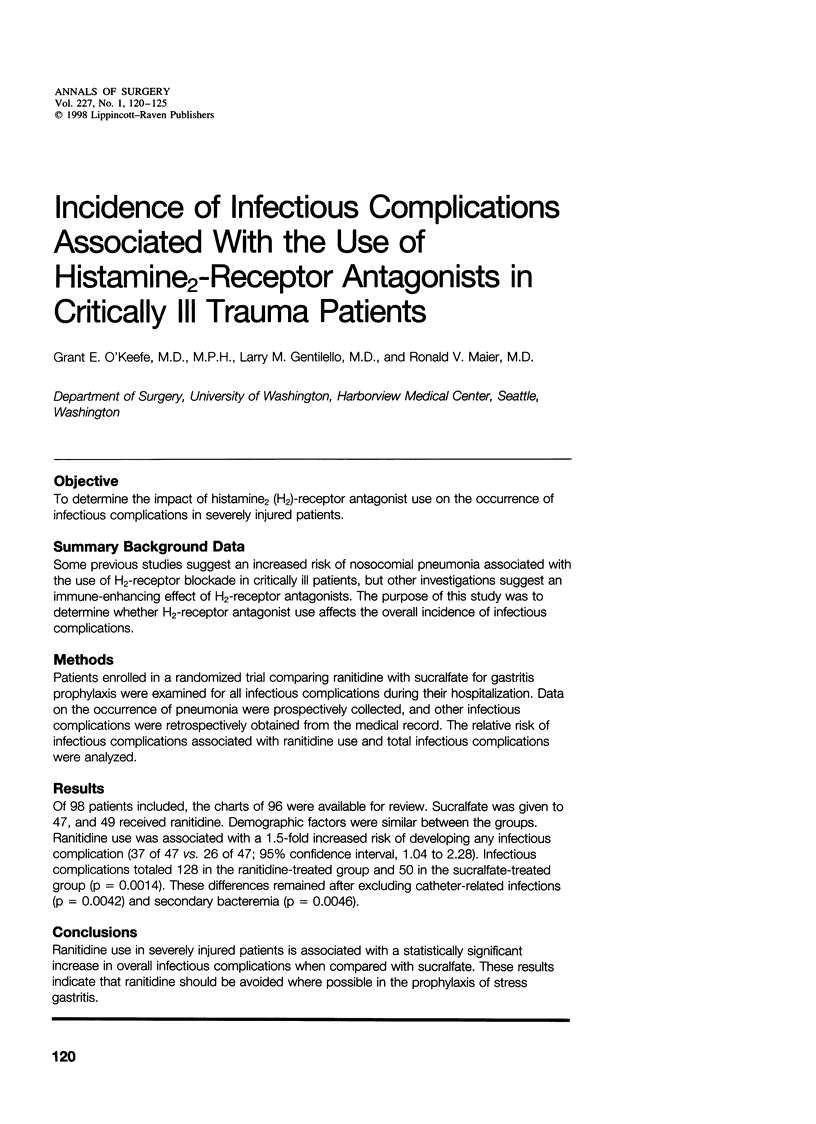
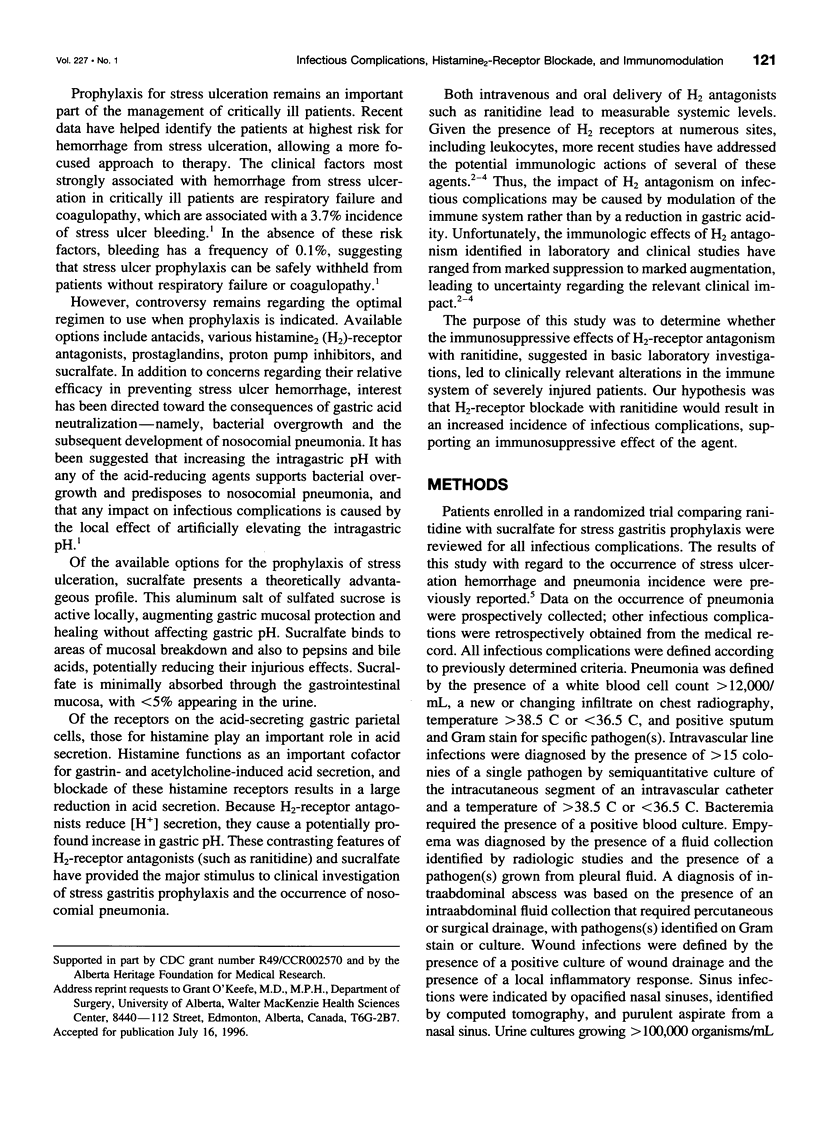
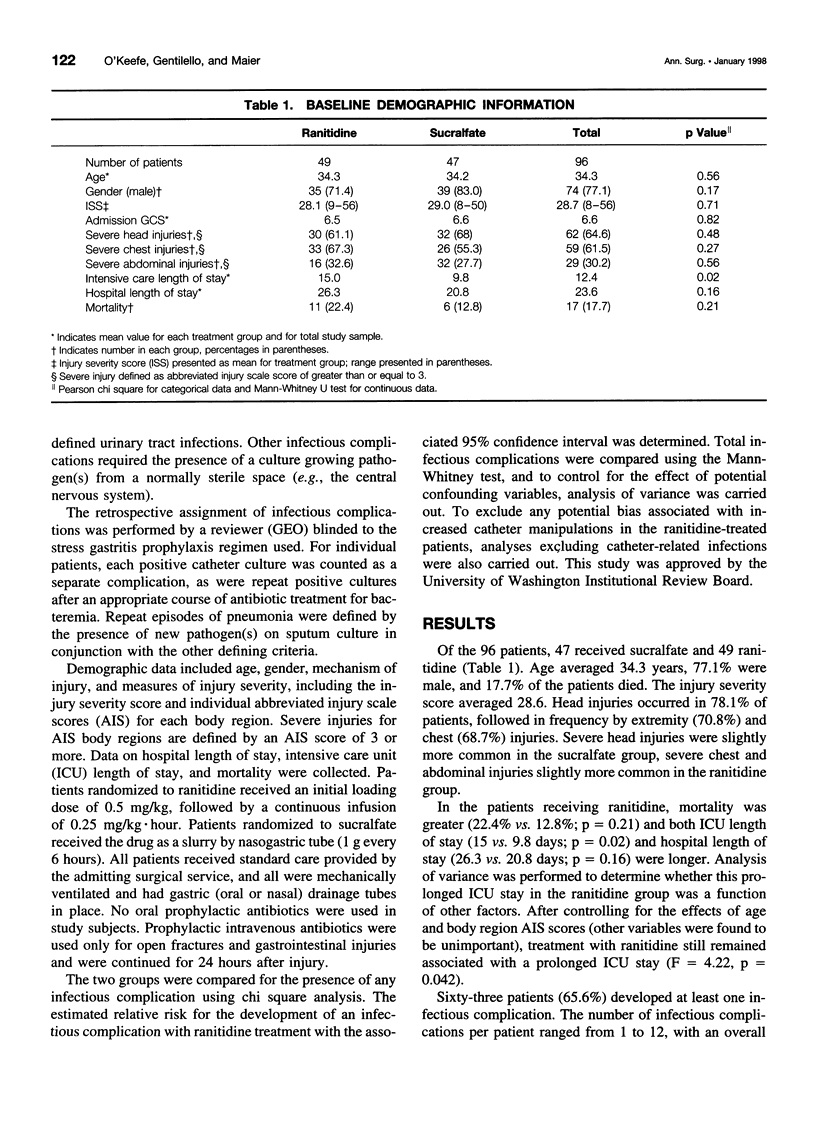
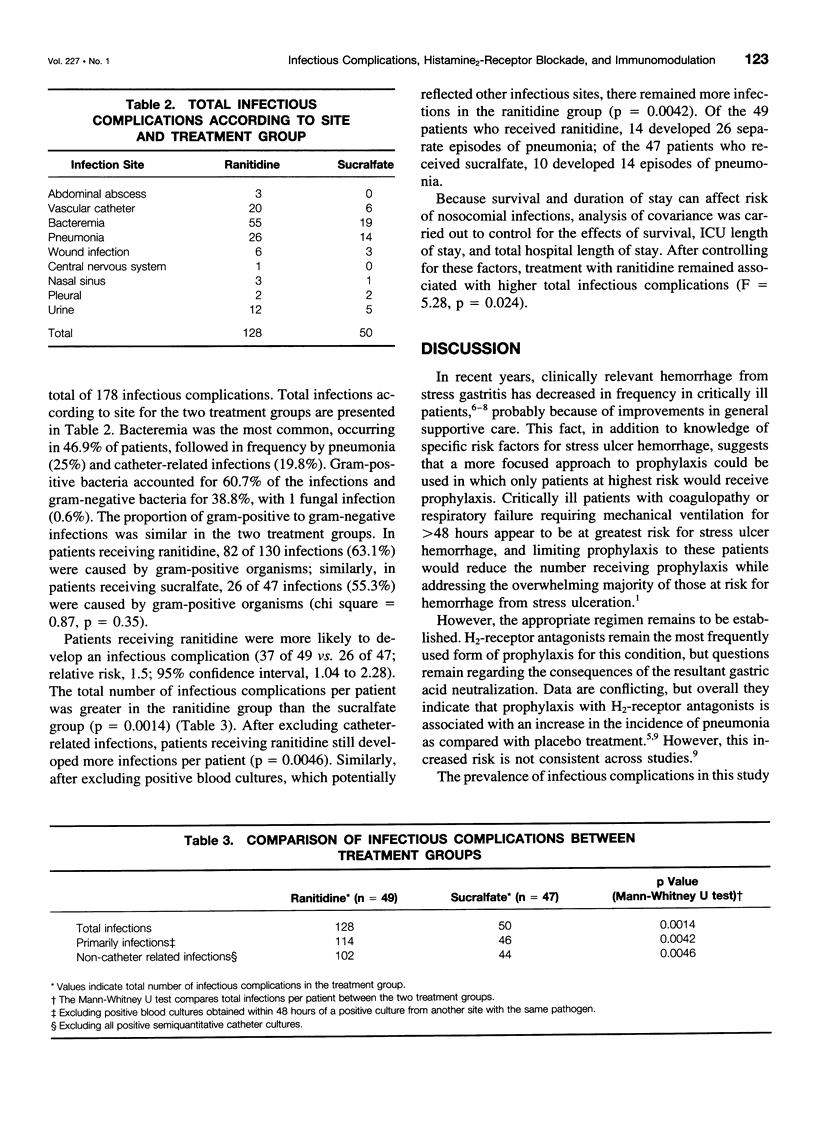
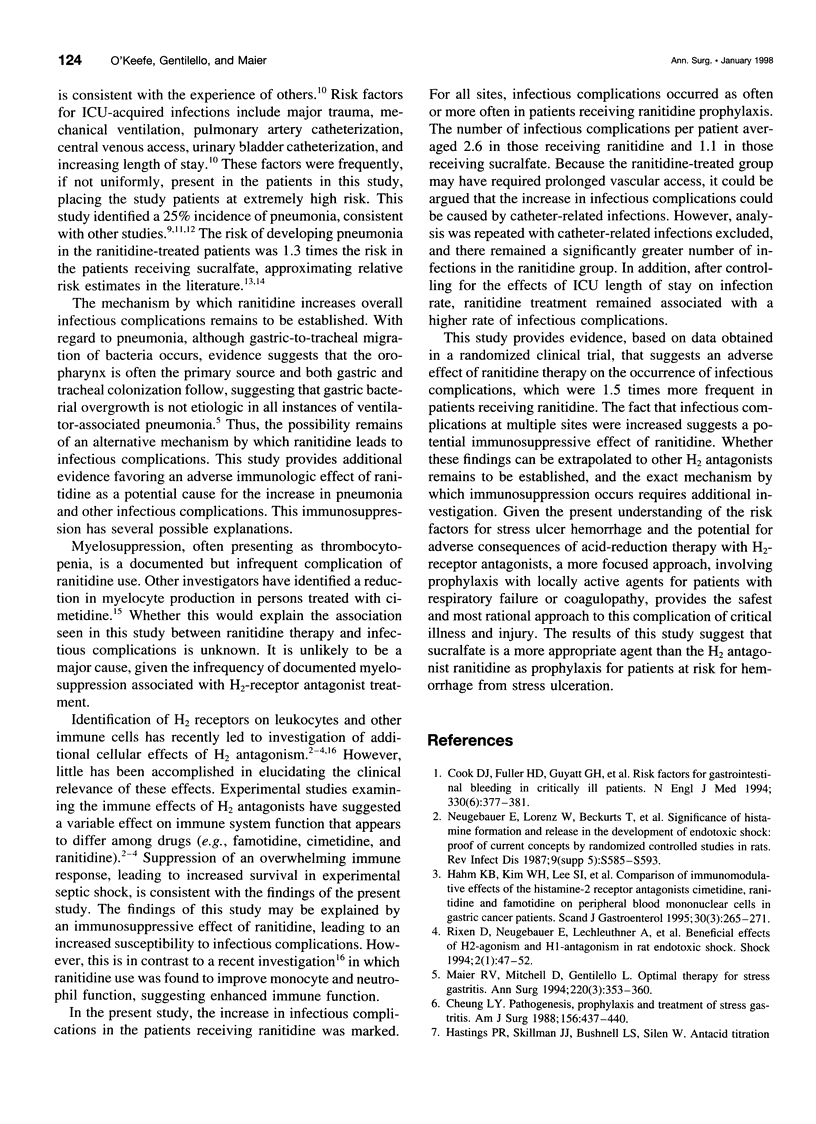
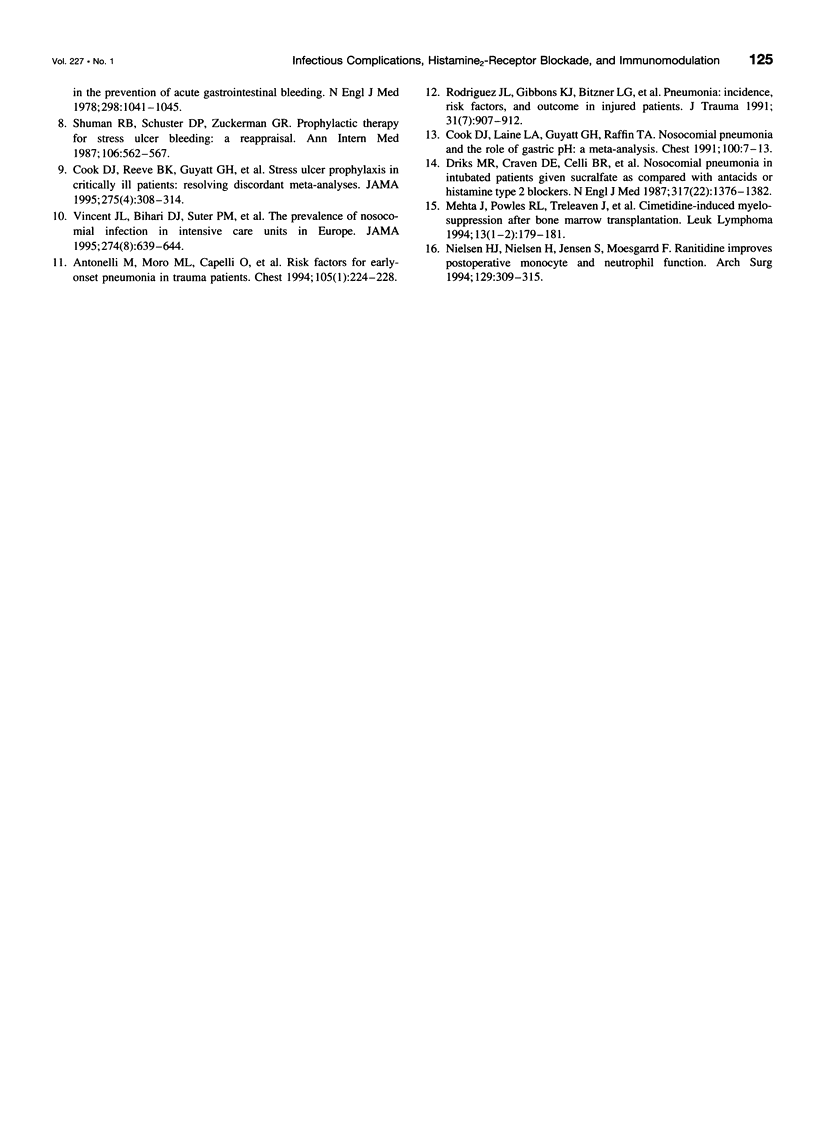
Selected References
These references are in PubMed. This may not be the complete list of references from this article.
- Antonelli M., Moro M. L., Capelli O., De Blasi R. A., D'Errico R. R., Conti G., Bufi M., Gasparetto A. Risk factors for early onset pneumonia in trauma patients. Chest. 1994 Jan;105(1):224–228. doi: 10.1378/chest.105.1.224. [DOI] [PubMed] [Google Scholar]
- Cheung L. Y. Thomas G Orr Memorial Lecture. Pathogenesis, prophylaxis, and treatment of stress gastritis. Am J Surg. 1988 Dec;156(6):437–440. doi: 10.1016/s0002-9610(88)80522-1. [DOI] [PubMed] [Google Scholar]
- Cook D. J., Fuller H. D., Guyatt G. H., Marshall J. C., Leasa D., Hall R., Winton T. L., Rutledge F., Todd T. J., Roy P. Risk factors for gastrointestinal bleeding in critically ill patients. Canadian Critical Care Trials Group. N Engl J Med. 1994 Feb 10;330(6):377–381. doi: 10.1056/NEJM199402103300601. [DOI] [PubMed] [Google Scholar]
- Cook D. J., Laine L. A., Guyatt G. H., Raffin T. A. Nosocomial pneumonia and the role of gastric pH. A meta-analysis. Chest. 1991 Jul;100(1):7–13. doi: 10.1378/chest.100.1.7. [DOI] [PubMed] [Google Scholar]
- Cook D. J., Reeve B. K., Guyatt G. H., Heyland D. K., Griffith L. E., Buckingham L., Tryba M. Stress ulcer prophylaxis in critically ill patients. Resolving discordant meta-analyses. JAMA. 1996 Jan 24;275(4):308–314. [PubMed] [Google Scholar]
- Driks M. R., Craven D. E., Celli B. R., Manning M., Burke R. A., Garvin G. M., Kunches L. M., Farber H. W., Wedel S. A., McCabe W. R. Nosocomial pneumonia in intubated patients given sucralfate as compared with antacids or histamine type 2 blockers. The role of gastric colonization. N Engl J Med. 1987 Nov 26;317(22):1376–1382. doi: 10.1056/NEJM198711263172204. [DOI] [PubMed] [Google Scholar]
- Hahm K. B., Kim W. H., Lee S. I., Kang J. K., Park I. S. Comparison of immunomodulative effects of the histamine-2 receptor antagonists cimetidine, ranitidine, and famotidine on peripheral blood mononuclear cells in gastric cancer patients. Scand J Gastroenterol. 1995 Mar;30(3):265–271. doi: 10.3109/00365529509093275. [DOI] [PubMed] [Google Scholar]
- Hastings P. R., Skillman J. J., Bushnell L. S., Silen W. Antacid titration in the prevention of acute gastrointestinal bleeding: a controlled, randomized trial in 100 critically ill patients. N Engl J Med. 1978 May 11;298(19):1041–1045. doi: 10.1056/NEJM197805112981901. [DOI] [PubMed] [Google Scholar]
- Maier R. V., Mitchell D., Gentilello L. Optimal therapy for stress gastritis. Ann Surg. 1994 Sep;220(3):353–363. doi: 10.1097/00000658-199409000-00011. [DOI] [PMC free article] [PubMed] [Google Scholar]
- Mehta J., Powles R. L., Treleaven J., Shields M., Agrawal S., Rege K., Mitchell P., Allard S. Cimetidine-induced myelosuppression after bone marrow transplantation. Leuk Lymphoma. 1994 Mar;13(1-2):179–181. doi: 10.3109/10428199409051669. [DOI] [PubMed] [Google Scholar]
- Neugebauer E., Lorenz W., Beckurts T., Maroske D., Merte H. Significance of histamine formation and release in the development of endotoxic shock: proof of current concepts by randomized controlled studies in rats. Rev Infect Dis. 1987 Sep-Oct;9 (Suppl 5):S585–S593. doi: 10.1093/clinids/9.supplement_5.s585. [DOI] [PubMed] [Google Scholar]
- Nielsen H. J., Nielsen H., Jensen S., Moesgaard F. Ranitidine improves postoperative monocyte and neutrophil function. Arch Surg. 1994 Mar;129(3):309–315. doi: 10.1001/archsurg.1994.01420270087019. [DOI] [PubMed] [Google Scholar]
- Rixen D., Neugebauer E., Lechleuthner A., Buschauer A., Nagelschmidt M., Thoma S., Rink A. Beneficial effect of H2-agonism and H1-antagonism in rat endotoxic shock. Shock. 1994 Jul;2(1):47–52. [PubMed] [Google Scholar]
- Rodriguez J. L., Gibbons K. J., Bitzer L. G., Dechert R. E., Steinberg S. M., Flint L. M. Pneumonia: incidence, risk factors, and outcome in injured patients. J Trauma. 1991 Jul;31(7):907–914. [PubMed] [Google Scholar]
- Shuman R. B., Schuster D. P., Zuckerman G. R. Prophylactic therapy for stress ulcer bleeding: a reappraisal. Ann Intern Med. 1987 Apr;106(4):562–567. doi: 10.7326/0003-4819-106-4-562. [DOI] [PubMed] [Google Scholar]
- Vincent J. L., Bihari D. J., Suter P. M., Bruining H. A., White J., Nicolas-Chanoin M. H., Wolff M., Spencer R. C., Hemmer M. The prevalence of nosocomial infection in intensive care units in Europe. Results of the European Prevalence of Infection in Intensive Care (EPIC) Study. EPIC International Advisory Committee. JAMA. 1995 Aug 23;274(8):639–644. [PubMed] [Google Scholar]


